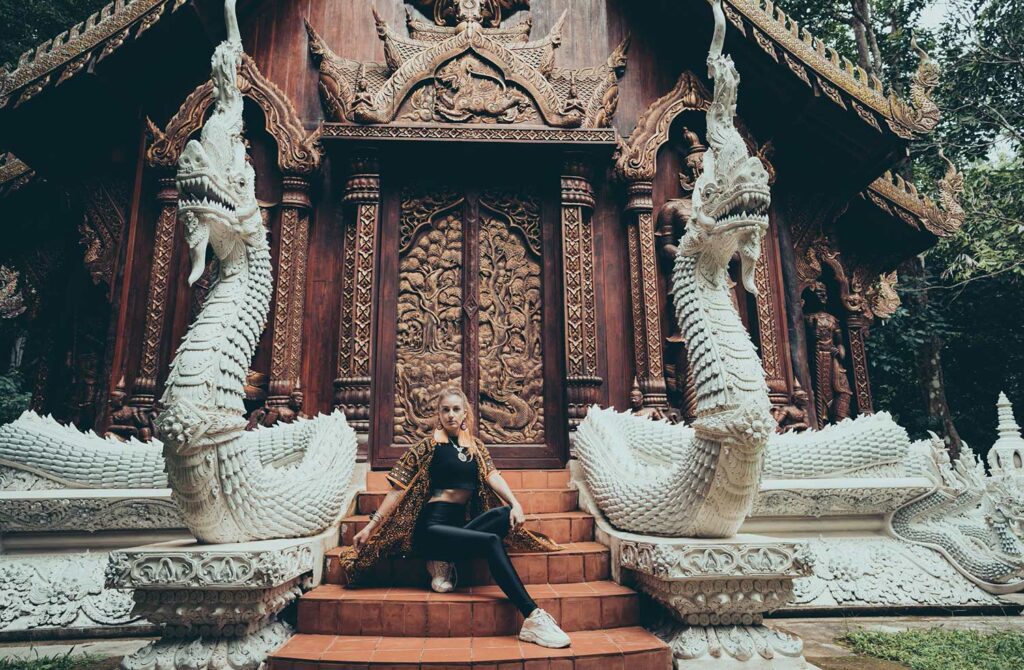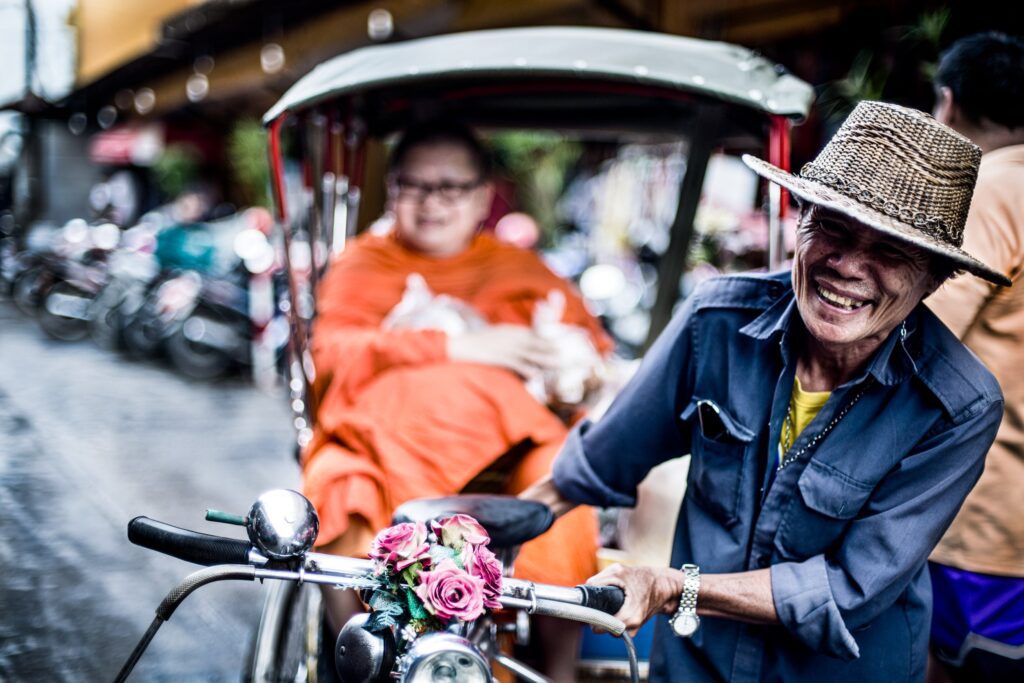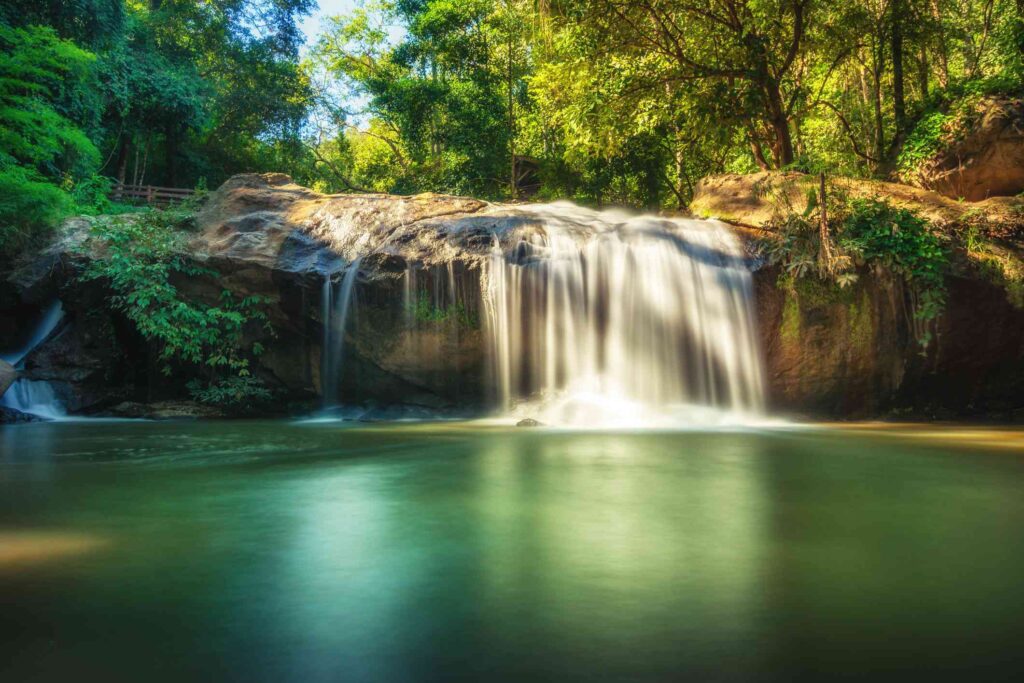Chiang Mai, a city nestled in the mountainous landscape of Northern Thailand, is a photographer’s dream. Its blend of scenic beauty, rich cultural heritage, and unique urban charm provides endless opportunities for both professional and amateur photographers. This guide aims to introduce the abundant photographic possibilities that Chiang Mai offers, along with practical advice to capture its essence through the lens.
Overview of Chiang Mai’s Scenic and Cultural Photography Opportunities
Chiang Mai’s diverse landscape offers a plethora of subjects for photographers. The city’s old town, surrounded by ancient walls and moats, is a treasure trove of traditional Lanna architecture, bustling markets, and serene temples like the iconic Wat Phra Singh and Wat Chedi Luang. Each corner of the city tells a story, making it perfect for street and architectural photography.
Beyond the urban scenery, Chiang Mai’s natural surroundings are equally captivating. The lush countryside, with its rolling hills, rice paddies, and tranquil villages, provides a stark contrast to the city’s busy streets. Locations like Doi Inthanon National Park and the serene settings of local hill tribes offer stunning landscapes and cultural insights.
Understanding the Light and Climate for Optimal Photography Conditions
Lighting plays a crucial role in photography, and Chiang Mai’s climate offers a variety of lighting conditions. The best times for photography are often during the early mornings and late afternoons when the light is softer and the colors more vibrant. The city’s rainy season, from July to October, brings dynamic weather conditions, offering dramatic cloud formations and softer light post-rain showers, ideal for landscape and nature photography.
Equipment and Preparation Tips for Photography Enthusiasts
Camera Gear: A DSLR or mirrorless camera with a versatile lens (like a 24-70mm) is ideal for capturing a wide range of subjects. For street photography, a smaller, less conspicuous camera might be more suitable.
Additional Equipment: Consider bringing a tripod for landscape shots, especially during sunrise or sunset. A polarizing filter can also be beneficial to manage reflections and enhance the sky’s color.
Batteries and Storage: Always carry extra batteries and memory cards. The last thing you want is to run out of power or storage during a perfect photographic moment.
Respect and Sensitivity: When photographing local people, especially in rural or tribal areas, it’s important to ask for permission as a sign of respect. Understanding and adhering to cultural norms is crucial.
Scouting Locations: Spend some time exploring areas to understand the best angles and times for shooting. Local guides or photography tours can offer valuable insights and access to hidden gems.
In summary, Chiang Mai’s photographic charm lies in its rich cultural tapestry and natural beauty. Whether you’re capturing the hustle of the night markets, the serenity of the temples, or the majesty of the northern landscapes, the city offers a myriad of opportunities to create stunning visual narratives. With the right preparation, respect for the culture, and an eye for detail, photography enthusiasts can fully immerse themselves in capturing the essence of this enchanting city.


Iconic Temples and Historical Sites
Chiang Mai, a city steeped in history and spirituality, is home to some of Thailand’s most iconic temples and historical sites. These temples are not just places of worship; they are architectural masterpieces and windows into the past, offering incredible opportunities for photography enthusiasts. Here’s a guide to capturing the beauty and essence of some of Chiang Mai’s most photogenic temples.
Highlighting the Most Photogenic Temples
Wat Phra Singh: This temple, located in the heart of the Old City, is renowned for its Lanna-style architecture and the intricately carved golden façade of its main building. The temple’s serene atmosphere is heightened by the presence of saffron-robed monks and the gentle sound of temple bells.
Wat Chedi Luang: A monumental structure in the center of Chiang Mai, Wat Chedi Luang is famous for its massive chedi (pagoda) that dates back to the 14th century. The temple complex’s ancient ruins and large Buddha statues offer a blend of historical grandeur and spiritual calmness.
Wat Umong: Nestled in a forested area, Wat Umong is known for its unique tunnel system and tranquil setting. The temple’s natural surroundings, combined with its ancient structures, create a mystical ambiance ideal for photography.
Best Times to Photograph These Historic Sites
Capturing these temples in the best light while avoiding crowds requires strategic planning:
Early Morning: Visiting just after sunrise not only offers soft, diffused light but also fewer crowds. The morning light accentuates the temples’ intricate details and creates a serene mood in your photographs.
Late Afternoon: The golden hour before sunset brings a warm glow to the temples, ideal for capturing their majesty and creating dramatic silhouettes.
Festival Days: While more crowded, festivals like Loy Krathong or Yi Peng can offer unique photographic opportunities with the temples lit up and lively with cultural activities.
Tips for Respectful and Creative Temple Photography
While photographing these sacred sites, it’s important to do so respectfully and creatively:
Dress Appropriately: Wear modest clothing that covers your shoulders and knees as a sign of respect when entering temple grounds.
Seek Permission: Always ask for permission before photographing monks or worshippers. Be discreet and respectful of those who are there to pray or meditate.
Use Natural Light: Utilize natural light to capture the true essence of the temple’s architecture and its surroundings. Flash photography can be intrusive and is often not allowed inside the temple halls.
Incorporate Elements of Culture: Include elements such as monks, worshippers, and religious artifacts in your compositions to add depth and context to your photographs.
Explore Different Angles: Look for unique perspectives and compositions. Capturing reflections, using doorways or windows as frames, and finding lesser-known corners can result in more interesting photographs.
In essence, Chiang Mai’s temples are not just architectural marvels but symbols of the city’s rich cultural and religious heritage. Photographing these sites offers a chance to delve deeper into the artistic and spiritual life of Chiang Mai, capturing moments of tranquility, beauty, and historical significance. With respect and creativity, each photograph taken here can tell a story of its own.


The Vibrancy of Street Life and Markets
Chiang Mai’s streets, a mosaic of vibrant scenes and bustling activity, offer photographers a canvas to capture the essence of the city’s dynamic urban life. From the sprawling markets to the narrow alleyways, each turn presents a new opportunity to document the everyday hustle and bustle, the colors, and the textures that define Chiang Mai.
Capturing the Essence of Chiang Mai’s Street Life
The streets of Chiang Mai are alive with a unique blend of traditional Thai culture and modern energy. The city’s local markets, street vendors, traditional artisans, and spirited festivals provide endless subjects for street photography. Key elements to focus on include the lively interactions at market stalls, the intricate details of street food preparation, and the vibrant array of goods ranging from handcrafted textiles to local produce.
Tips for Photographing the Sunday Walking Street and Other Local Markets
Timing: Visit the markets during different times to capture the varying moods – early mornings for the setup and prep activities, and evenings for the bustling crowds and vibrant night scenes.
Gear: A fast lens is ideal for street photography in markets, allowing for a shallow depth of field to focus on subjects and capture candid moments in low light conditions.
Perspective: Experiment with different perspectives. High-angle shots from above can capture the expanse of the markets, while ground-level shots offer a more immersive feel.
Techniques for Candid Shots and Street Photography Etiquette
Candid Shots: For natural, candid shots, observe your surroundings and anticipate moments. Patience is key. Be ready to capture interactions and expressions that tell a story.
Discretion: While capturing the candidness of street life, it’s important to be discreet and not intrusive. A smaller camera can be less intimidating than a large DSLR.
Respect: Always show respect to the people you’re photographing. If someone seems uncomfortable, it’s polite to stop shooting. In some cases, a smile and a nod can be enough to seek permission.
Focus on Details: Sometimes, the essence of a place is best captured in the details – a vendor’s hands, the texture of fabrics, the array of local fruits and vegetables.
Lighting: Make the most of natural light. Early morning and late afternoon light can provide a beautiful glow and depth to your street photography.
Chiang Mai’s street life and markets are not just about capturing images; they’re about capturing the spirit of the city. It’s a place where the old and new converge, where every frame tells a story of tradition, livelihood, and the vibrancy of city life. Whether you’re a seasoned photographer or a hobbyist, Chiang Mai’s streets offer a rich tapestry of scenes waiting to be captured through your lens.


Nature and Landscape Photography
Chiang Mai’s natural beauty, with its lush landscapes, serene waterfalls, and majestic mountains, provides a magnificent backdrop for nature and landscape photography. Capturing the essence of these natural wonders requires not just skill but also an understanding of the best locations and optimal times for photography.
Scouting the Best Locations for Capturing Chiang Mai’s Natural Beauty
Doi Inthanon National Park: Known as the “Roof of Thailand”, this park boasts the highest peak in the country. It offers breathtaking views, lush forests, and stunning waterfalls like Mae Ya and Wachirathan.
Doi Suthep-Pui National Park: Home to the famous Wat Phra That Doi Suthep Temple, this park also offers panoramic views of Chiang Mai city, especially beautiful at sunrise or sunset.
Huay Tung Tao Lake: A serene spot ideal for capturing reflections of the surrounding mountains and the everyday life of local fishermen.
Mae Sa Valley: Known for its elephant camps and orchid farms, this valley provides a diverse landscape for photography, combining natural beauty with cultural elements.
Tips for Photographing Landscapes, Waterfalls, and the Surrounding Mountains
Golden Hour: Capture landscapes during the golden hour (shortly after sunrise or before sunset) for soft, diffused light and dramatic skies.
Long Exposure: For waterfalls, use a tripod and a slower shutter speed to create a smooth, flowing effect with the water.
Composition: Pay attention to the composition. Use leading lines, rule of thirds, and natural framing to create balanced and interesting shots.
Weather Conditions: Overcast days can provide even lighting for landscapes and help to avoid harsh shadows.
Best Times for Capturing Sunrises, Sunsets, and Natural Light
Sunrise: For sunrises, locations like Doi Suthep and Doi Inthanon offer stunning vistas. Arrive early to set up and capture the changing colors of the sky.
Sunset: Huay Tung Tao Lake and Mae Sa Valley are great for sunsets. The reflections on the water can add an extra element to your photographs.
Blue Hour: Don’t pack up immediately after the sun sets. The blue hour (the period of twilight each evening) offers a unique, ethereal quality of light that is perfect for landscapes.
Natural Light: Utilize natural light as much as possible. Early mornings and late afternoons provide the best light for nature photography, offering warmth and depth.
In summary, Chiang Mai’s diverse natural landscape is a playground for photographers. Whether it’s capturing the grandeur of its mountains and forests or the tranquility of its waterfalls and valleys, there is no shortage of spectacular scenes to be immortalized through your lens. With the right timing, light, and composition, the natural beauty of Chiang Mai can be captured in all its glory.


Off the Beaten Path – Unconventional Photo Spots
Chiang Mai’s allure isn’t limited to its well-known attractions; the city and its surroundings are replete with hidden gems and lesser-known spots that offer unique photographic perspectives. Venturing off the beaten path allows photographers to capture the essence of Chiang Mai’s urban and rural areas in a fresh and unconventional way. This exploration not only broadens one’s photographic portfolio but also deepens one’s connection to the locale.
Exploring Lesser-Known Locations for Unique Photographic Perspectives
Wiang Kum Kam: An ancient city buried under years of silt, Wiang Kum Kam offers ruins and artifacts that tell stories of a bygone era. It’s a place where history meets tranquility.
Baan Kang Wat Artist Village: A little out of the city, this artist village is a hub of creativity. With its unique architecture and artisan shops, it offers a different view of Chiang Mai’s culture.
Mon Cham: Located in the Nong Hoi Valley, Mon Cham offers stunning mountainous landscapes and agricultural terraces, ideal for landscape and portrait photography.
Mae Wang District: For those willing to venture a bit further, Mae Wang provides a serene countryside experience with its small villages, rivers, and elephant sanctuaries.
Capturing the Hidden Gems of Chiang Mai’s Urban and Rural Areas
Back Alleys and Side Streets: The back alleys of the Old City are full of surprises. From ancient walls to contemporary street art, these areas provide a contrast to the typical temple shots.
Local Markets: Beyond the famous ones, smaller local markets offer a glimpse into everyday life in Chiang Mai. They are places of vibrant colors and candid moments waiting to be captured.
Rural Temples: While the grand temples get most of the attention, the smaller, rural temples offer a more intimate and serene setting for photography.
Encouraging Exploration and Discovery Through Photography
Go on a Photo Walk: Sometimes the best way to discover hidden gems is to simply pick a direction and start walking. Be open to what might come your way and ready to capture it.
Talk to Locals: Engaging with locals can lead to recommendations for spots that are off the tourist radar. Plus, these interactions can become meaningful subjects for your photography.
Be Respectful: When you’re venturing into less-touristy areas, it’s crucial to be respectful of the people and their property. Always ask for permission before taking photos.
Keep an Open Mind: Not all unconventional spots will look promising at first glance. Sometimes, the most mundane or overlooked places can offer the most striking images.
In Chiang Mai, every street corner, every market, and every rural path has a story waiting to be told through the lens. It’s a city that rewards the curious and the adventurous with photographic opportunities that encapsulate its true spirit. By exploring these lesser-known locations, photographers not only add depth and diversity to their work but also gain a more profound appreciation for the city’s hidden beauty and the stories it holds.
Conclusion
As we conclude this exploration of photography in Chiang Mai, it’s evident that this city offers a wealth of opportunities for photographers to create a rich and varied portfolio. From the ancient temples casting shadows in the early morning light to the bustling markets alive with color and energy at night, Chiang Mai is a place where every moment holds the potential for a beautiful photograph.
Key Takeaways for Photography Enthusiasts in Chiang Mai
Diversity of Subjects: Chiang Mai’s blend of cultural heritage, natural beauty, and urban vibrancy provides a diverse range of subjects for photographers of all interests and skill levels.
Understanding Light and Climate: The unique lighting conditions, influenced by Chiang Mai’s climate and geography, play a crucial role in photography, offering stunning opportunities for capturing landscapes, cityscapes, and cultural scenes.
Exploring Beyond the Obvious: While iconic temples and popular tourist spots offer classic images, venturing off the beaten path into lesser-known areas can yield unique and compelling photographs.
Engaging with the Community: Chiang Mai’s friendly locals and vibrant expat community offer chances not just for candid street photography but also for deeper, more meaningful cultural exchanges.
Encouraging Ethical and Responsible Photography
As photographers, it’s crucial to approach our craft with respect and sensitivity, especially when capturing the essence of a place and its people:
Cultural Sensitivity: Be aware of and respectful towards local customs and traditions, especially when photographing religious sites and ceremonies.
Consent: Always seek permission before photographing individuals, particularly in rural or tribal areas.
Environmental Awareness: Be mindful of your impact on natural sites and landscapes. Leave no trace and respect wildlife and natural habitats.
Final Thoughts on Making the Most of Chiang Mai’s Photographic Potential
Chiang Mai is not just a destination; it’s an experience that unfolds differently through the lens of each photographer. Whether you’re strolling through the quiet lanes of the old city at dawn or capturing the lively atmosphere of a night market, the city offers endless opportunities to create and tell stories through your images.
So, pack your camera, embrace the adventure, and let Chiang Mai reveal its many faces to you. Each photograph you take is a piece of the city’s story and a part of your journey as a photographer. In Chiang Mai, every snapshot is an invitation to look deeper, explore further, and connect more profoundly with the world around you.








